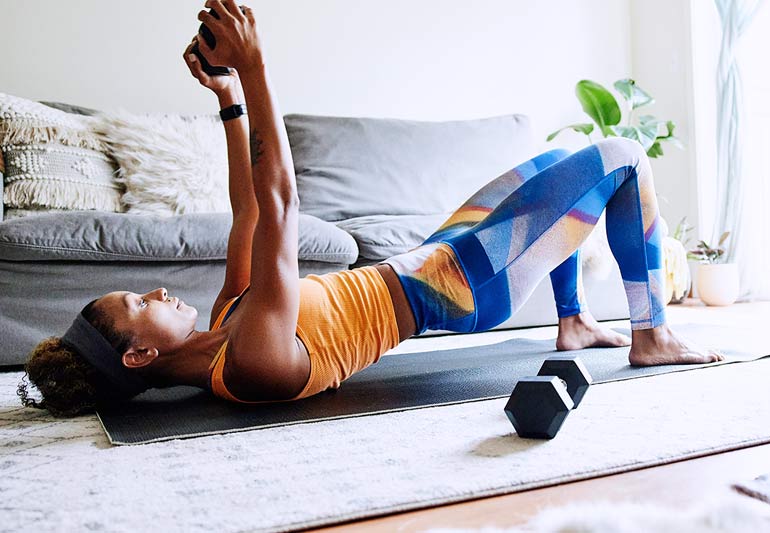 Even the most dedicated exercise enthusiast can have a hard time in winter. Cold days and long nights make it hard to get out of bed, let alone get the body moving, but there are simple ways to get motivated when the weather outside is frightful. The goal is to remove as many obstacles as possible and make small changes that can make staying active easier until spring returns. At this time of year, exercise can also help to cope with seasonal depression. Here are 11 tips on how to motivate yourself to stay active in the winter. 1. Seek out an exercise partner or group When exercising alone, there is only one person you have to convince to skip a session. But by exercising with a partner or group, there’s some social pressure. Exercise partners can also provide social support, camaraderie and distraction from bad weather. There’s the additional benefit of making friends and hanging out with like-minded people, he added. Even if you're exercising at home, consider joining a live class on Zoom or on Instagram — which are great winter workout options that don't require you to brave the cold. 2. Enlist the thermostat in your cause If the schedule calls for early workouts, program the thermostat in the morning to ensure a cozy atmosphere for waking up and place workout clothes near a heater so they’re nice and warm. 3. Make it a goal just to get to the gym Just focus on getting dressed and showing up at the health club or in your living room in front of your laptop, nothing else. Then, it's OK to do an abbreviated workout or leave after a few minutes. (Most people don’t.) Once you’re there, the problem is solved. You’re kind of committed. Once you’ve changed into your gear, once you’ve made the initial step, the rest of it is a lot easier. 4. Exercise during your lunch break Many people get frustrated when it’s dark in the morning and dark when they come home from work. The solution is to work out in the middle of the day, during the peak light hours. If the weather is tolerable, take a long, brisk walk during lunch hour — this provides the added benefit of fresh air and a bit of nature. If there’s too much snow in the way, head to a nearby mall or shopping center for an indoor stroll. 5. Focus on the mental health benefits Many people who start exercising get frustrated when they don’t lose weight or feel fit right away. But those benefits take a while to show up. The mental health benefits, on the other hand, happen almost immediately. People feel better, less stressed and more relaxed, which may be especially important during the hectic holiday season and a time when many suffer from seasonal affective disorder. Feel good about doing something for yourself that we know has so many benefits that so many people need. 6. Plan ahead and anticipate For outdoor workouts, watch the weather forecast and know what you’ll be up against the next day, whether snow or a cold blast. Plan the appropriate clothing by stocking up on some workout clothes for winter and have everything ready when for wake up time: gear, gym bag and snack. If you know what you’re going to have to experience or endure, it doesn’t bother you as much. 7. Put on exercise clothes when coming home from work This simple goal puts people on the right path without much effort. The idea behind doing that is you’ve met your goal and it’s probably difficult to take those exercise clothes off without actually doing some form of exercise. 8. Sleep in exercise clothes This is a more intense variation of the goal above. The advantage is being ready to go right out of bed in clothes that are warm and already in place. On the other hand, the ritual of getting into exercise clothes can be energizing. Once you start gearing up, you’re getting your head in the game. It’s like a pre-game ritual. 9. Swim in a warm pool If exercising in the cold just isn't something you're willing to do, indoor swimming can be a great cardio option. Swimming is one of the best sports for a long and healthy life. A warm indoor pool can be the perfect place for a workout when the weather outside doesn’t cooperate. 10. Optimize the morning alarm Choose a song that will get out of bed and get the heart beating faster. That’s when the race begins, so don’t hit the snooze button. If you’re giving yourself a couple of options to snooze, you’re done a lot of the time, especially when your options are work out in the cold or stay warm and cozy in bed. 11. Reconsider starting an outdoor exercise program as a New Year’s resolution Winter is really a bad time to do it, but unfortunately, a lot of people start January 1. It’s just a penalty on top of a penalty. People have been overindulging, they feel guilty, they feel like they have to do it and then they’re starting at a time when the environment is kind of conspiring against them. It's better to start with baby steps and start somewhere warm.
0 Comments
 Do you workout five days a week and take the weekends off? Are you sure you want to do that? Here’s how I look at it. You work Monday through Friday, eight hours a day and are completely exhausted. Most of the time you force yourself to workout after work/school or before. I find that stressful. And isn’t stress one of the main factors in weight gain? After torturing yourself throughout the week rushing to workouts, work/school and life you crash on the weekends. In my opinion, weekends are the best time to workout. If you want to workout five days a week, fine! Just space it out to make it less stressful. Take two of your busiest workdays off to rest and workout on the weekends instead. Here are ten good reasons to workout on the weekends.
 For fitness success, set goals that are specific, measurable, attainable, relevant and time-bound We know that keeping ourselves physically fit is important. Regular exercise is good for our minds and our bodies. And whether you’re a dedicated fitness buff or just getting started, it turns out that your fitness routine could benefit from taking a cue from the business world. Specifically, setting goals. And — even more specifically — setting SMART goals. SMART is an acronym for goals that are:
SMART fitness goals are a framework for how you’re going to achieve certain results. If we don’t have something that we’re moving toward or a plan to get there, we can get lost and lose motivation. Setting SMART fitness goals allows you space to consider what you really want to achieve in your exercise program, and by when. What are SMART fitness goals? SMART goals are a way to systematically and thoughtfully approach an objective. They were first introduced by business consultants in the 1980s to help employees define (and ultimately, meet) their work objectives, but the approach extends beyond office culture. Think about it like this: If a business owner’s goal for the next quarter is to “make more money,” that doesn’t tell you how they’re going to get there or how much cash they want to bring in. It’s not a solid plan for success. Similarly, a fitness goal to “get healthier” doesn’t give you a useful blueprint to work from. That’s where SMART goals come into play. If you don’t have a defined goal and a plan to reach it, you can start at a program, but you’re likely to be all over the place — not focused and maybe even unmotivated. Setting specific, measurable goals can provide a ‘spark’ and hold you accountable as you work to improve your fitness level. Here is how to set goals to work out SMARTer, not harder. Let’s start with this example SMART fitness goal: In the next three months, I will increase my current average step count from 6,000 steps per day to 8,000 steps per day. Specific A goal to improve your average number of steps per day is targeted and specific. More than a plan to “walk more,” this goal includes starting point and a target expectation. Measurable SMART fitness goals need to be trackable — otherwise, how can you know if you’re achieving the desired result? And how do you know when you get to back yourself on the back for a job well done? In the above example of increasing steps per day, you have a certain number of steps to work toward. And using a pedometer or other step-counting device, you can measure how you’re moving toward meeting that goal. Attainable If you’re new to consistent exercise, it’s not very likely (or advisable) to plan to run a marathon in a month. Setting goals that are within an achievable range will help ensure that you have the proper motivation to reach them and that you’re setting yourself up for success. If you set your sights too high, too fast, it’s easy to get frustrated and give up. You can also injure yourself if you’re trying to push too far to reach an unreasonable goal. In this example, the goal to increase steps by an average of 2,000 steps per day can be attainable, yet it’s a big enough change that you’ll need to push a little harder than usual in order to achieve the goal. Whether a fitness goal is attainable depends on where you’re starting from in your fitness journey, how much time and energy you have to devote to your new routine, and how motivated you are to achieve your goal. Relevant Setting a relevant SMART fitness goal means thinking about the ends you’re trying to achieve and finding the path to get there. If your reason for increasing your step count is to achieve an overall improvement in your health, you’re on the right track. Walking can burn some extra calories, relieve stress, improve your energy and more. If those are the kinds of benefits you’re looking for, you’re on track with a relevant workout goal. Congrats! But if what you’re really working toward is increased flexibility to relieve pain in your shoulders, the step-count goal won’t really get you there. A more relevant goal would focus on incorporating more stretching or yoga into your day. Time-bound A time-bound goal means setting a timeframe, sometimes even a specific date that you can circle on your calendar, by which you plan to have achieved the goal. Adding a time-sensitive element to your goal means you’ll be able to plan the incremental changes you need to achieve the goal and set milestones along the way. Examples of SMART fitness goals Because SMART goals take into account your current fitness level and your personal desires, goals are likely to be very different from person to person. That’s what makes them personalized and more likely to make you successful in sticking to them and achieving results. In general, short-term fitness goals should be things you plan to achieve in the next six months or less. Anything longer than that is considered a more long-term goal. Consider these example SMART fitness goal examples to get you started on setting your own goals. Short-term: By fall, I’ll run a 5K. Long-term: This time next year, I’ll run a 10K.
Short-term: For the next six months, I’ll go to two yoga classes per week. Long-term: By this time next year, I’ll work on advanced poses in higher-intensity yoga classes.
Short-term: I’ll be able to do 25 knee push-ups in a row without being fatigued in the next three months. Long-term: In a year, I’ll do 50 regular pushups in a row.
Holding yourself accountable OK, so now it’s all out there on paper. You’ve set a solid SMART goal and have a reason to push yourself to new limits. (Yay!) Now comes the real work. Accountability is the key to achieving the goals you set out for yourself. Sometimes, people don’t appreciate how much work actually goes into actually meeting their goals. Changing your habits can be intense and uncomfortable, but it’s worth it. It’ll help to have a plan in place not only for what you’re going to achieve but also the steps you’re taking to get there. Here are ways to track your progress toward meeting your fitness goals:
Working toward a new goal can be exciting, and maybe even daunting. But breaking it all down into short-term plans and long-term goals that are attainable and measurable can help take some of the guesswork out of the equation. And it keeps you physically and mentally on track to make changes in your life. If you’re still not sure where to start or are looking for advice, we suggest talking with a fitness professional — like a fitness coach or personal trainer — to help you set a SMART goal, make a plan to achieve it and give you a nudge along the way.  Are you thinking about starting a fitness program? Good for you! You're only five steps away from a healthier lifestyle. Starting a fitness program may be one of the best things you can do for your health. Physical activity can lower the risk of long-lasting disease and improve balance and coordination. It can help with weight loss, sleep and self-esteem. And you can start a fitness program in only five steps. 1. Measure your fitness level You probably have some idea of how fit you are. But find out for sure. Learn about your fitness level and write down your scores before you start your program. Use the scores as benchmarks against which to measure your progress. To measure your aerobic and muscular fitness, flexibility, and body composition, write down:
2. Design your fitness program It's easy to say that you'll exercise every day. But you'll need a plan. As you design your fitness program, keep these points in mind:
3. Gather your equipment You'll probably start with athletic shoes. Be sure to pick shoes made for the activity you have in mind. For example, running shoes weigh less than cross-training shoes, which offer more support. If you're planning to buy exercise equipment, choose something that's practical, fun and easy to use. You may want to try out some types of equipment at a gym or fitness center before buying your own equipment. Try using fitness apps for smart devices or other activity tracking devices. You can use them to track the distance you walk, track calories you burn or check your heart rate. 4. Get started Now you're ready for action. As you begin your fitness program, keep these tips in mind:
5. Check your progress Assess your fitness six weeks after you start your program. Then do it again every few months. How are you doing? You may need to add more exercise time. Or you may find that you're exercising about the right amount to meet your fitness goals. If you lose motivation, set new goals or try a new activity. Exercise with a friend or take a class at a fitness center. Starting an exercise program is an important decision. But it doesn't have to be an overwhelming one. By planning carefully and pacing yourself, you can begin a healthy habit that lasts a lifetime.  Are you ready to make this your year to take control of your health and fitness? If you’ve had New Year’s fitness resolutions that didn’t stick in the past and you want to make a change this year, the first step is recognizing where your good intentions fell off and didn’t result in action. It’s not that you didn’t have what it took to succeed, but more likely that you didn’t clearly define your goals and develop a fool-proof action plan. Use the tips below to set yourself up for success and ensure your fitness resolution fires up instead of fizzles out this year. Focus on Daily Habits Rather Than End Results Big, ambitious goals are accomplished through small daily habits. Instead of setting New Year’s resolutions that are focused on the distant end goal, like “run a marathon” or “lose thirty pounds”, focus on the consistent steps needed to get there. Once you know where you want to be in three, six, or twelve months, work backwards and get granular to define what you need to do every day to reach your goal. Taking small steps consistently will help you bridge the gap from where you are to where you want to be. For example, if your goal is to lose 10 pounds, decide how much time you will dedicate to daily exercise and healthy meal planning. Plan what days you will work out during the week, and for how long. Develop or download a meal plan and write out your grocery list. Decide which day of the week you’ll meal prep and block out specific times on your schedule. Shifting your mindset to focus on actionable steps that change your daily lifestyle, rather than letting the days go by without taking action, will help you make real progress and keep your motivation levels high. Write Out Your Goal & Place It Somewhere You’ll See Every Day Take a moment to write out your resolution and place it somewhere you will see first thing in the morning. This is an effective way to keep your goal front of mind as you start each day and reaffirm why you’re making positive daily lifestyle changes. Whether you place a sticky note on the bathroom mirror or magnet it to the fridge, this small visual reminder can make a huge difference. Pro tip: If you’re interested in tracking your daily progress and milestones, try using a planner or calendar. You can use this tool to plan your weekly workouts and meals, record what you did each day to move toward your goal, and write notes on what you’ve learned so far. This will also help you plan how to best fit your new practices into your regular routine. Be Realistic & Start Small If you never workout, don’t start with a goal that involves working out 6 days a week. You’ll get burnt out before the first week is up. Instead, set a smaller, more attainable goal that won’t overwhelm you. Start with 30 minutes 3 days a week while you build your strength and stamina up. Once that becomes a habit, add another day or an additional 15 minutes to the 3 days. It’s important to build a solid foundation first. Studies show it takes 66 days on average to form a habit. So, if you stick with your smaller goals for 2-3 months, it will be much easier to keep it going and accomplish bigger goals. Find an Accountability Buddy or Join a Group There’s power in numbers. Surrounding yourself with people working towards similar goals will help keep you motivated and disciplined. If you don’t have someone in your circle of friends or family who will hold you accountable, consider joining a local class or club. Activity trackers can also help give you a little boost of motivation each day. Reward Your Small Accomplishments Keep yourself motivated to achieve your New Year’s fitness resolution by deciding on a reward for small accomplishments along the way. Going back to the example at the beginning, if your goal is to lose 10 pounds, reward yourself for every 2 pounds you lose with something fun and exciting, but that won’t set you back. For example, new yoga pants, a night out dancing with friends, tickets to the next game of your favorite sports team, a cooking class, etc. It’s important to decide the rewards and milestones in advance though, so you always know what you’re working toward. New Year’s fitness resolutions can be an amazing way to set intentions for your year, reset your priorities, and achieve your goals. If you start with a clear action plan, a strong community, and a positive mindset, you’re off to a great start on your journey! |
AuthorBrian Lowe Archives
January 2024
Categories |

 RSS Feed
RSS Feed